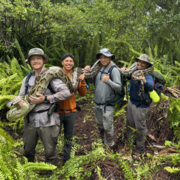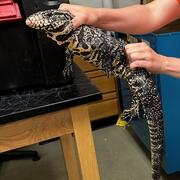Amy Yackel Adams, PhD
Amy Yackel Adams is a Research Ecologist focusing on improving management decisions of invasive reptiles worldwide.
Amy leads a diverse research program with other USGS scientists and various collaborators (NPS, USDA-NWRC, USFWS, DoD, universities, and state agencies) pertaining to early detection and rapid response, biology, ecology, genetics, control tool evaluation, eradication, and quantitative model development to improve adaptive management of invasive reptile species. Yackel Adams’ research areas in the Greater Everglades Ecosystem and Pacific Islands include: 1) Population and vital rate estimation of invasive Burmese Pythons, Veiled Chameleons, and Brown Treesnakes; 2) Estimating the impact of Brown Treesnakes on prey populations; 3) Enhancing early detection of invasive reptiles using new tools; and 4) Development and evaluation of removal and abundance models to inform and optimize eradication efforts.
Education and Certifications
PhD, Ecology, Graduate Degree Program in Ecology, Colorado State University, 2005
MS, Ecology, Graduate Degree Program in Ecology, Colorado State University, 1999
BS, Resource Conservation and Environmental Studies, University of Montana, 1986
Science and Products
Invasive Burmese python research in the Greater Everglades
Land management research in support of streamlined energy development, economic growth, and wildfire management
Early detection and rapid response tools for invasive tegu lizards
Invasive species science in support of public safety, America’s natural resources, and economic growth
Developing and evaluating a point-of-use environmental DNA test for rapid field detection of highly invasive brown treesnakes
Fort Collins Science Center Labs and Facilities
A citizen science program for brown treesnake removal and native species recovery at a National Historical Park in Guam
Multi-year Burmese Python Vital Rate Research Collaborative in the Greater Everglades
State Partnerships in South Florida
Biology, Impacts and Control of Invasive Reptiles in the Everglades
Ecology and Control of Invasive Reptiles in Florida
Mentoring the next generation: USGS, NPS, and University of Florida Cooperative Research Unit Invasive Reptile Intern Program
Argentine black and white tegu (Salvator merianae) morphometrics and gastrointestinal contents, Florida, 2016-2021 Argentine black and white tegu (Salvator merianae) morphometrics and gastrointestinal contents, Florida, 2016-2021
Oviposition and pipping observations for three wild adult female Burmese pythons (Python molurus bivittatus) in southern Florida Oviposition and pipping observations for three wild adult female Burmese pythons (Python molurus bivittatus) in southern Florida
Model outputs of habitat suitability for three invasive tegu lizards across the contiguous United States under current and future climate scenarios Model outputs of habitat suitability for three invasive tegu lizards across the contiguous United States under current and future climate scenarios
Data and analytical code to model the growth rate of brown treesnakes (Boiga irregularis), Guam 2004-2013 Data and analytical code to model the growth rate of brown treesnakes (Boiga irregularis), Guam 2004-2013
Morphometric data of Burmese python and White-tailed deer in South Florida associated with a feeding event, 2025 Morphometric data of Burmese python and White-tailed deer in South Florida associated with a feeding event, 2025
Photographic sequence of brooding Burmese python (Python bivittatus) and associated temperature of record-sized nest in Big Cypress National Preserve, FL, June to August 2022 Photographic sequence of brooding Burmese python (Python bivittatus) and associated temperature of record-sized nest in Big Cypress National Preserve, FL, June to August 2022
Guam, Morphometric and height data for brown treesnakes were detected at four sites on Guam, 2006 - 2023 Guam, Morphometric and height data for brown treesnakes were detected at four sites on Guam, 2006 - 2023
Capsaicin-treated bait trials for Argentine Black and White Tegu lizards in Georgia and Florida, USA 2020-2021 Capsaicin-treated bait trials for Argentine Black and White Tegu lizards in Georgia and Florida, USA 2020-2021
Brown treesnake (Boiga irregularis) scanning and behavioral data collected in experimental setup in Guam for testing remote PIT-tag reader Brown treesnake (Boiga irregularis) scanning and behavioral data collected in experimental setup in Guam for testing remote PIT-tag reader
Diet of invasive Burmese Pythons (Python molorus bivittatus) in southern Florida, 1995-2020 Diet of invasive Burmese Pythons (Python molorus bivittatus) in southern Florida, 1995-2020
Serpentoviruses in free-ranging invasive pythons and native colubrids in southern Florida, United States, 2018-2020 Serpentoviruses in free-ranging invasive pythons and native colubrids in southern Florida, United States, 2018-2020
Brown treesnake movement following snake suppression in the Habitat Management Unit on Northern Guam from 2015 Brown treesnake movement following snake suppression in the Habitat Management Unit on Northern Guam from 2015
Post-hatching maternal attendance in wild Burmese Pythons in southern Florida Post-hatching maternal attendance in wild Burmese Pythons in southern Florida
Consumption of a non-native Walking Catfish (Clarias batrachus) by a Florida Green Watersnake (Nerodia floridana) in Everglades National Park Consumption of a non-native Walking Catfish (Clarias batrachus) by a Florida Green Watersnake (Nerodia floridana) in Everglades National Park
Cold-induced vomiting of a white-tailed deer (Odocoileus virginianus) by an invasive Burmese python (Python bivitattus) in Big Cypress National Preserve, Florida, USA Cold-induced vomiting of a white-tailed deer (Odocoileus virginianus) by an invasive Burmese python (Python bivitattus) in Big Cypress National Preserve, Florida, USA
Modeling current and future distribution of invasive tegu lizards along geopolitical boundaries in the contiguous United States: Implications for invasion threat Modeling current and future distribution of invasive tegu lizards along geopolitical boundaries in the contiguous United States: Implications for invasion threat
Growth rate variation in Brown Treesnakes (Boiga irregularis): An invasive species of conservation concern Growth rate variation in Brown Treesnakes (Boiga irregularis): An invasive species of conservation concern
Coelomic foreign bodies in wild-caught Python spp. in the Greater Everglades Ecosystem, Florida, USA Coelomic foreign bodies in wild-caught Python spp. in the Greater Everglades Ecosystem, Florida, USA
An Eastern Ribbonsnake, Thamnophis sauritus (Linnaeus, 1766), scavenging on a roadkilled Cuban Treefrog, Osteopilus septentrionalis, (Duméril & Bibron, 1841), in Everglades National Park, Florida, USA An Eastern Ribbonsnake, Thamnophis sauritus (Linnaeus, 1766), scavenging on a roadkilled Cuban Treefrog, Osteopilus septentrionalis, (Duméril & Bibron, 1841), in Everglades National Park, Florida, USA
Wild Burmese python nest site selection, thermogenesis, and brooding behaviors in the Greater Everglades Ecosystem Wild Burmese python nest site selection, thermogenesis, and brooding behaviors in the Greater Everglades Ecosystem
Development and evaluation of the remote passive integrated transponder tag reader for customizable monitoring of wildlife Development and evaluation of the remote passive integrated transponder tag reader for customizable monitoring of wildlife
An early detection rapid response case study of the Black and White Tegu (Salvator merianae) and implications for a broader framework An early detection rapid response case study of the Black and White Tegu (Salvator merianae) and implications for a broader framework
Using camera traps to estimate site occupancy of invasive Argentine Black and White Tegus (Salvator merianae) in South Florida Using camera traps to estimate site occupancy of invasive Argentine Black and White Tegus (Salvator merianae) in South Florida
Identifying Pareto-efficient eradication strategies for invasive populations Identifying Pareto-efficient eradication strategies for invasive populations
Non-USGS Publications**
**Disclaimer: The views expressed in Non-USGS publications are those of the author and do not represent the views of the USGS, Department of the Interior, or the U.S. Government.
Identifying Pareto-efficient eradication strategies for invasive populations Identifying Pareto-efficient eradication strategies for invasive populations
Science and Products
Invasive Burmese python research in the Greater Everglades
Land management research in support of streamlined energy development, economic growth, and wildfire management
Early detection and rapid response tools for invasive tegu lizards
Invasive species science in support of public safety, America’s natural resources, and economic growth
Developing and evaluating a point-of-use environmental DNA test for rapid field detection of highly invasive brown treesnakes
Fort Collins Science Center Labs and Facilities
A citizen science program for brown treesnake removal and native species recovery at a National Historical Park in Guam
Multi-year Burmese Python Vital Rate Research Collaborative in the Greater Everglades
State Partnerships in South Florida
Biology, Impacts and Control of Invasive Reptiles in the Everglades
Ecology and Control of Invasive Reptiles in Florida
Mentoring the next generation: USGS, NPS, and University of Florida Cooperative Research Unit Invasive Reptile Intern Program
Argentine black and white tegu (Salvator merianae) morphometrics and gastrointestinal contents, Florida, 2016-2021 Argentine black and white tegu (Salvator merianae) morphometrics and gastrointestinal contents, Florida, 2016-2021
Oviposition and pipping observations for three wild adult female Burmese pythons (Python molurus bivittatus) in southern Florida Oviposition and pipping observations for three wild adult female Burmese pythons (Python molurus bivittatus) in southern Florida
Model outputs of habitat suitability for three invasive tegu lizards across the contiguous United States under current and future climate scenarios Model outputs of habitat suitability for three invasive tegu lizards across the contiguous United States under current and future climate scenarios
Data and analytical code to model the growth rate of brown treesnakes (Boiga irregularis), Guam 2004-2013 Data and analytical code to model the growth rate of brown treesnakes (Boiga irregularis), Guam 2004-2013
Morphometric data of Burmese python and White-tailed deer in South Florida associated with a feeding event, 2025 Morphometric data of Burmese python and White-tailed deer in South Florida associated with a feeding event, 2025
Photographic sequence of brooding Burmese python (Python bivittatus) and associated temperature of record-sized nest in Big Cypress National Preserve, FL, June to August 2022 Photographic sequence of brooding Burmese python (Python bivittatus) and associated temperature of record-sized nest in Big Cypress National Preserve, FL, June to August 2022
Guam, Morphometric and height data for brown treesnakes were detected at four sites on Guam, 2006 - 2023 Guam, Morphometric and height data for brown treesnakes were detected at four sites on Guam, 2006 - 2023
Capsaicin-treated bait trials for Argentine Black and White Tegu lizards in Georgia and Florida, USA 2020-2021 Capsaicin-treated bait trials for Argentine Black and White Tegu lizards in Georgia and Florida, USA 2020-2021
Brown treesnake (Boiga irregularis) scanning and behavioral data collected in experimental setup in Guam for testing remote PIT-tag reader Brown treesnake (Boiga irregularis) scanning and behavioral data collected in experimental setup in Guam for testing remote PIT-tag reader
Diet of invasive Burmese Pythons (Python molorus bivittatus) in southern Florida, 1995-2020 Diet of invasive Burmese Pythons (Python molorus bivittatus) in southern Florida, 1995-2020
Serpentoviruses in free-ranging invasive pythons and native colubrids in southern Florida, United States, 2018-2020 Serpentoviruses in free-ranging invasive pythons and native colubrids in southern Florida, United States, 2018-2020
Brown treesnake movement following snake suppression in the Habitat Management Unit on Northern Guam from 2015 Brown treesnake movement following snake suppression in the Habitat Management Unit on Northern Guam from 2015
Post-hatching maternal attendance in wild Burmese Pythons in southern Florida Post-hatching maternal attendance in wild Burmese Pythons in southern Florida
Consumption of a non-native Walking Catfish (Clarias batrachus) by a Florida Green Watersnake (Nerodia floridana) in Everglades National Park Consumption of a non-native Walking Catfish (Clarias batrachus) by a Florida Green Watersnake (Nerodia floridana) in Everglades National Park
Cold-induced vomiting of a white-tailed deer (Odocoileus virginianus) by an invasive Burmese python (Python bivitattus) in Big Cypress National Preserve, Florida, USA Cold-induced vomiting of a white-tailed deer (Odocoileus virginianus) by an invasive Burmese python (Python bivitattus) in Big Cypress National Preserve, Florida, USA
Modeling current and future distribution of invasive tegu lizards along geopolitical boundaries in the contiguous United States: Implications for invasion threat Modeling current and future distribution of invasive tegu lizards along geopolitical boundaries in the contiguous United States: Implications for invasion threat
Growth rate variation in Brown Treesnakes (Boiga irregularis): An invasive species of conservation concern Growth rate variation in Brown Treesnakes (Boiga irregularis): An invasive species of conservation concern
Coelomic foreign bodies in wild-caught Python spp. in the Greater Everglades Ecosystem, Florida, USA Coelomic foreign bodies in wild-caught Python spp. in the Greater Everglades Ecosystem, Florida, USA
An Eastern Ribbonsnake, Thamnophis sauritus (Linnaeus, 1766), scavenging on a roadkilled Cuban Treefrog, Osteopilus septentrionalis, (Duméril & Bibron, 1841), in Everglades National Park, Florida, USA An Eastern Ribbonsnake, Thamnophis sauritus (Linnaeus, 1766), scavenging on a roadkilled Cuban Treefrog, Osteopilus septentrionalis, (Duméril & Bibron, 1841), in Everglades National Park, Florida, USA
Wild Burmese python nest site selection, thermogenesis, and brooding behaviors in the Greater Everglades Ecosystem Wild Burmese python nest site selection, thermogenesis, and brooding behaviors in the Greater Everglades Ecosystem
Development and evaluation of the remote passive integrated transponder tag reader for customizable monitoring of wildlife Development and evaluation of the remote passive integrated transponder tag reader for customizable monitoring of wildlife
An early detection rapid response case study of the Black and White Tegu (Salvator merianae) and implications for a broader framework An early detection rapid response case study of the Black and White Tegu (Salvator merianae) and implications for a broader framework
Using camera traps to estimate site occupancy of invasive Argentine Black and White Tegus (Salvator merianae) in South Florida Using camera traps to estimate site occupancy of invasive Argentine Black and White Tegus (Salvator merianae) in South Florida
Identifying Pareto-efficient eradication strategies for invasive populations Identifying Pareto-efficient eradication strategies for invasive populations
Non-USGS Publications**
**Disclaimer: The views expressed in Non-USGS publications are those of the author and do not represent the views of the USGS, Department of the Interior, or the U.S. Government.













